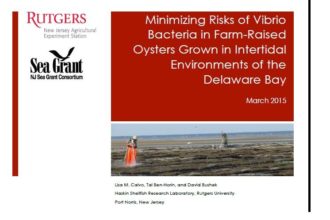New Jersey’s oyster farms are concentrated on the extensive intertidal sand flats of the lower Delaware Bay where they are exposed twice daily during low tide. The project manager conducted a preliminary study to test whether this result applies to mid-Atlantic intertidal environments.
The project did not reveal a significant difference between levels of total and pathogenic Vibrio between subtidal and intertidal oysters, nor was there a significant increase in Vibrio burdens over the time course of low-tide exposure. This initial result suggests that the relationship between grow-out conditions and Vibrio levels in oysters is not as straightforward as previously thought, and highlights the need for locally relevant aquaculture practices to minimize the risk of Vibrio illness.
Want more information? See the related SARE grant:
This material is based upon work that is supported by the National Institute of Food and Agriculture, U.S. Department of Agriculture through the Sustainable Agriculture Research and Education (SARE) program. Any opinions, findings, conclusions, or recommendations expressed in this publication are those of the author(s) and should not be construed to represent any official USDA or U.S. Government determination or policy.
